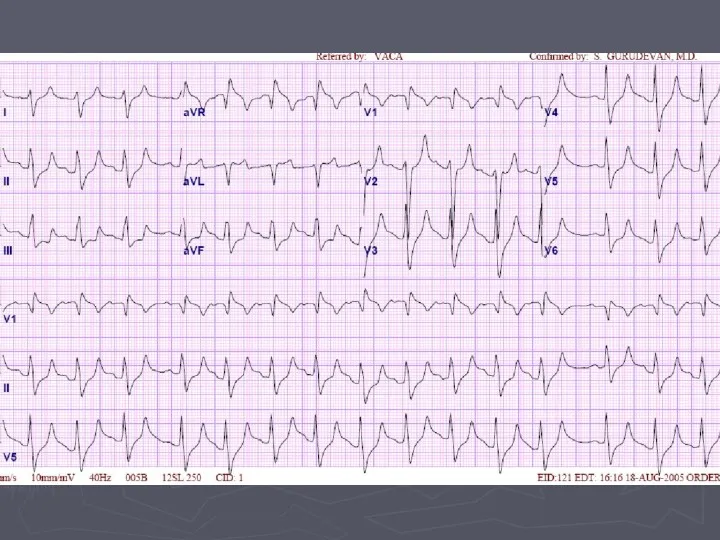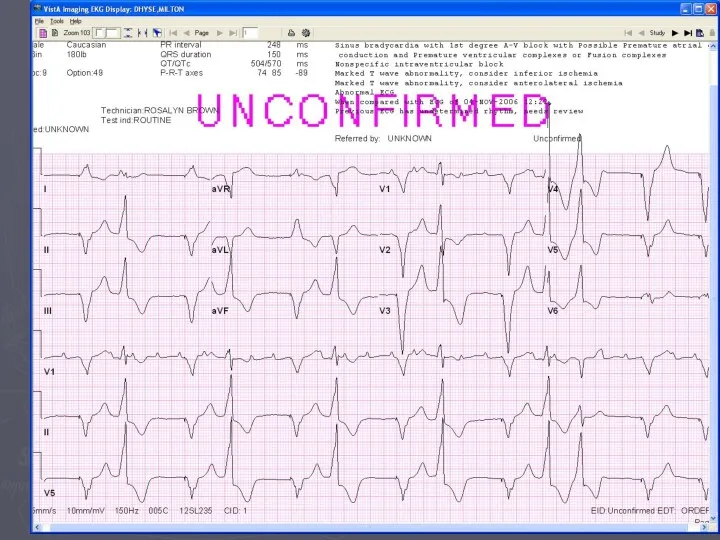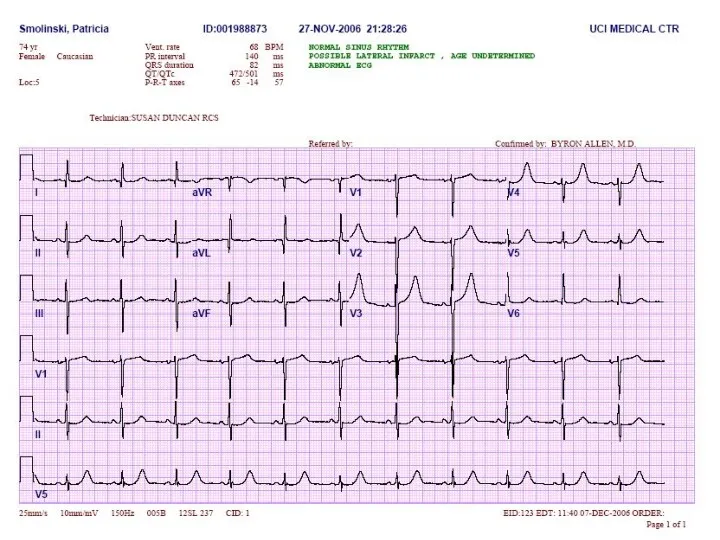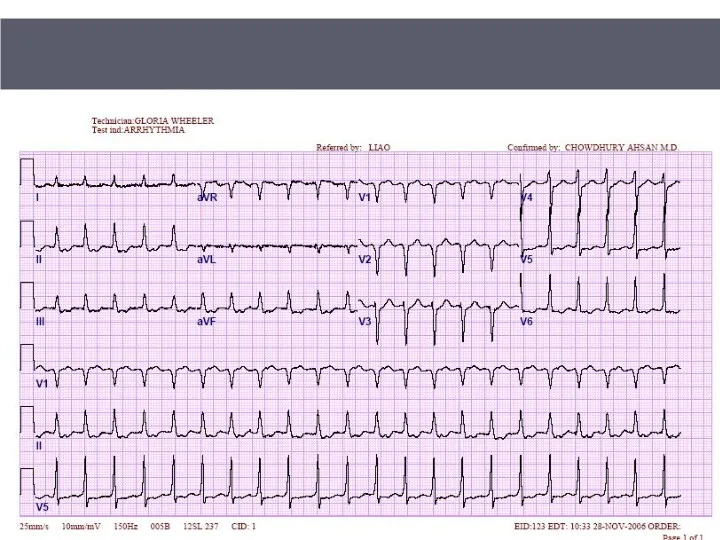Содержание
- 2. Outline Review of the conduction system QRS breakdown Rate Axis Rhythms
- 3. The Normal Conduction System
- 4. Waveforms and Intervals
- 5. EKG Leads The standard EKG has 12 leads: 3 Standard Limb Leads 3 Augmented Limb Leads
- 6. Standard Limb Leads
- 7. All Limb Leads
- 8. Precordial Leads Adapted from: www.numed.co.uk/electrodepl.html
- 9. Precordial Leads
- 10. Anatomic Groups (Summary)
- 11. Rate Rule of 300 10 Second Rule
- 12. Rule of 300 Take the number of “big boxes” between neighboring QRS complexes, and divide this
- 13. What is the heart rate? (300 / 6) = 50 bpm www.uptodate.com
- 14. What is the heart rate? (300 / ~ 4) = ~ 75 bpm www.uptodate.com
- 15. What is the heart rate? (300 / 1.5) = 200 bpm
- 16. The Rule of 300 It may be easiest to memorize the following table:
- 17. 10 Second Rule As most EKGs record 10 seconds of rhythm per page, one can simply
- 18. What is the heart rate? 33 x 6 = 198 bpm The Alan E. Lindsay ECG
- 19. The QRS Axis By near-consensus, the normal QRS axis is defined as ranging from -30° to
- 20. Determining the Axis The Quadrant Approach The Equiphasic Approach
- 21. Determining the Axis Predominantly Positive Predominantly Negative Equiphasic
- 22. The Quadrant Approach 1. Examine the QRS complex in leads I and aVF to determine if
- 23. The Quadrant Approach 2. In the event that LAD is present, examine lead II to determine
- 24. Quadrant Approach: Example 1 Negative in I, positive in aVF ? RAD The Alan E. Lindsay
- 25. Quadrant Approach: Example 2 Positive in I, negative in aVF ? Predominantly positive in II ?
- 26. The Equiphasic Approach 1. Determine which lead contains the most equiphasic QRS complex. The fact that
- 27. Equiphasic Approach: Example 1 Equiphasic in aVF ? Predominantly positive in I ? QRS axis ≈
- 28. Equiphasic Approach: Example 2 Equiphasic in II ? Predominantly negative in aVL ? QRS axis ≈
- 29. Systematic Approach Rate Rhythm Axis Wave Morphology P, T, and U waves and QRS complex Intervals
- 30. Rhythms/Arrhythmias Sinus Atrial Junctional Ventricular
- 31. Sinus Rhythms: Criteria/Types P waves upright in I, II, aVF Constant P-P/R-R interval Rate Narrow QRS
- 32. Sinus Arrhythmias: Criteria/Types Normal Sinus Rhythm Sinus Bradycardia Sinus Tachycardia Sinus Arrhythmia
- 33. Normal Sinus Rhythm Rate is 60 to 100
- 34. Sinus Bradycardia Can be normal variant Can result from medication Look for underlying cause
- 35. Sinus Tachycardia May be caused by exercise, fever, hyperthyroidism Look for underlying cause, slow the rate
- 36. Sinus Arrhythmia Seen in young patients Secondary to breathing Heart beats faster
- 37. Atrial Arrhythmias: Criteria/Types P waves inverted in I, II and aVF Abnormal shape Notched Flattened Diphasic
- 38. Atrial Arrhythmias: Criteria/Types Premature Atrial Contractions Ectopic Atrial Rhythm Wandering Atrial Pacemaker Multifocal Atrial Tachycardia Atrial
- 39. Premature Atrial Contraction QRS complex narrow RR interval shorter than sinus QRS complexes P wave shows
- 40. Ectopic Atrial Rhythm Narrow QRS complex P wave inverted
- 41. Wandering Atrial Pacemaker 3 different P wave morphologies possible with ventricular rate
- 42. Multifocal Atrial Tachycardia 3 different P wave morphologies with ventricular rate> 100 bpm
- 43. Atrial Flutter Regular ventricular rate 150 bpm Varying ratios of F waves to QRS complexes, most
- 44. Atrial Flutter Tracing shows 6:1 conduction
- 45. Atrial Fibrillation Tracing shows irregularly irregular rhythm with no P waves Ventricular rate usually > 100
- 46. Atrial Fibrillation Tracing shows irregularly irregular rhythm with no P waves Ventricular rate is 40
- 47. Atrial Tachycardia Tracing shows regular ventricular rate with P waves that are different from sinus P
- 48. P wave May be absent Buried in QRS If present inverted in leads I, II, and
- 49. PR interval Rate: Varies Narrow QRS complex Junctional Arrhythmias: Criteria
- 50. Junctional Arrhythmias: Types Premature Junctional Contractions Junctional Escape Rhythm Accelerated Junctional Tachycardia Junctional Tachycardia Reentrant Tachycardia
- 51. Premature Junctional Contractions R-R interval is shorter Beat is early, narrow QRS complex Inverted P wave
- 52. Junctional Escape Rhythm Junctional origin Rate is 40 to 60
- 53. Accelerated Junctional Tachycardia Junctional origin Rate is 60 to 100
- 54. Junctional Tachycardia Junctional origin Rate is > 100
- 55. Secondary to bypass tract within AV node Premature Atrial Contraction (PAC) depolarizes AV Nodal Reentrant Tachycardia
- 56. Rate Summary Sinus Tachycardia - 100-160 BPM Atrial Tachycardia - 150-250 BPM Atrial Flutter - 150-250
- 57. AV Nodal Blocks Delay conduction of impulses from sinus node If AV node does not let
- 58. 1st Degree AV Block PR interval constant >.2 sec All impulses conducted
- 59. 2nd Degree AV Block Type 1 AV node conducted each impulse slower and finally no impulse
- 60. 2nd Degree AV Block Type 2 Constant PR interval AV node intermittently conducts no impulse
- 61. AV node conducts no impulse Atria and ventricles beat at intrinsic rate (80 and 40 respectively)
- 62. Caused by bypass tract AV node is bypassed, delay EKG shows short PR interval Upsloping to
- 63. Delta wave, short PR interval WPW
- 64. Ventricular Arrhythmias: Criteria/Types Wide QRS complex Rate : variable No P waves Premature Ventricular Contractions Idioventricular
- 65. Occurs earlier than sinus beat Wide, no P wave Premature Ventricular Contraction
- 66. Escape rhythm Rate is 20 to 40 bpm Idioventricular Rhythm
- 67. Rate is 40 to 100 bpm Accelerated Idioventricular Rhythm
- 68. Rate is > than 100 bpm Ventricular Tachycardia
- 69. Torsades de Pointes Occurs secondary to prolonged QT interval
- 70. Unorganized activity of ventricle Ventricular Tachycardia/Fibrillation
- 71. Ventricular Fibrillation
- 72. Chamber Enlargements
- 73. Differential Diagnosis Hypertension (HTN) Aortis Stenosis (AS) Aortic Insufficiency (AI) Hypertrophic Cardiomyopathy (HCM) Mitral Regurgitation (MR)
- 74. False positive Thin chest wall Status post mastectomy Race, Sex, Age Left Bundle Branch Block (LBBB)
- 75. EKG Criteria: Diagnosis of LVH
- 76. EKG Criteria -S V1, V2 + R V5,V6 > 35 42.5% 95% (Sokolow-Lyon) -R V5 orV6
- 77. LVH with Strain
- 78. Right Ventricular Hypertrophy Reversal of precordial pattern R waves prominent in V1 and V2 S waves
- 79. Right Ventricular Hypertrophy
- 80. Right Ventricular Hypertrophy: Causes Chronic Obstructive Pulmonary Disease Pulmonary HTN Primary Pulmonary Embolus Mitral Stenosis Mitral
- 81. Right Ventricular Hypertrophy: Causes Tricuspid Regurgitation Atrial Septal Defect Pulmonary Stenosis Tetralogy of Fallot Ventricular Septal
- 82. Mitral Stenosis Mitral Regurgitation Left ventricular hypertrophy Hypertension Aortic Stenosis Aortic Insufficiency Hypertrophic Cardiomyopathy Left Atrial
- 83. Left Atrial Enlargement: Criteria P wave Notch in P wave Any lead Peaks > 0.04 secs
- 84. Lead II
- 85. P Wave: Left Atrial Enlargement
- 86. Left Atrial Enlargement Lead V1
- 87. CHD Tricuspid Stenosis Pulmonary Stenosis COPD Pulmonary HTN Pulmonary Embolus Mitral Regurgitation Mitral Stenosis Right Atrial
- 88. Tall, peaked P wave > 2.5 mm in any lead Most prominent P waves in leads
- 89. Right Atrial Enlargement
- 90. Bundle Branch Blocks
- 91. Bundle Branch Blocks Complete QRS > .12 secs Incomplete QRS .10 - .12 secs Left Complete
- 92. Normal variant Idiopathic degeneration of the conduction system Cardiomyopathy Ischemic heart disease Aortic Stenosis Hyperkalemia Left
- 93. Criteria for Left Bundle Branch Block (LBBB) Bizarre QRS Morphology High voltage S wave in V1,
- 94. Left Bundle Branch Block
- 95. Right Bundle Branch Block: Causes Idiopathic degeneration of the conduction system Ischemic heart disease Cardiomyopathy Massive
- 96. Criteria for Right Bundle Branch Block (RBBB) QRS morphology Wide S wave in leads I and
- 97. Right Bundle Branch Block
- 98. Right Bundle Branch Block
- 99. Anterior Septal with RBBB
- 100. Ischemia and Infarction
- 101. Normal Complexes and Segments
- 102. J Point
- 103. Ischemia T wave inversion, ST segment depression Acute injury: ST segment elevation Dead tissue: Q wave
- 104. Measurements
- 105. ST-Segment Elevation
- 106. ST Segment Depression Can be characterised as:- Downsloping Upsloping Horizontal
- 107. EKG Changes: Ischemia → Acute Injury→ Infarction
- 108. Evolution of Transmural Infarction
- 110. Evolution of a Subendocardial Infarction
- 112. Hyperacute T waves
- 113. Q Waves Non Pathological Q waves Q waves of less than 2mm are normal Pathological Q
- 114. Look for Grouped Patterns (Footprints) ST Depressions = Ischemia ST Elevations = injury Q Waves &
- 115. Anterior Septal (Left Anterior Descending)
- 116. Anterior Lateral (Left Circumflex)
- 117. Inferior (Right Coronary Artery)
- 124. ST-T Wave Changes
- 125. Strain in Hypertrophy
- 126. Strain in LVH
- 127. Strain in RVH
- 128. Strain vs Infarction
- 129. Pericarditis
- 130. Digoxin Changes
- 131. Ventricular Aneurysm
- 132. T waves
- 133. Summary Basic physiology of the conduction system Origin of a normal EKG Systematic approach to reading
- 149. Скачать презентацию


















































































































































 Клинико-психологическое сопровождение в рамках третичной профилактики пожилых с болезнью Паркинсона
Клинико-психологическое сопровождение в рамках третичной профилактики пожилых с болезнью Паркинсона Хвороби шкіри
Хвороби шкіри Современные технологии диагностики нарушений речи
Современные технологии диагностики нарушений речи Особенности развития и обучения глухих детей
Особенности развития и обучения глухих детей Пневмоторакс - синдром скопления газа в плевральной полости
Пневмоторакс - синдром скопления газа в плевральной полости Вступ до хірургії. Базові хірургічні навички
Вступ до хірургії. Базові хірургічні навички Магнитно-резонансная томография. МРТ-ангиография. Трактусовая МРТ-метрия. Преимущества и недостатки МРТ
Магнитно-резонансная томография. МРТ-ангиография. Трактусовая МРТ-метрия. Преимущества и недостатки МРТ Гипертонический криз
Гипертонический криз Тазовое предлежание плода в матке
Тазовое предлежание плода в матке СПИД и его профилактика
СПИД и его профилактика Терапиялық стоматология. Ауыз қуысының кәсіби гигиенасы
Терапиялық стоматология. Ауыз қуысының кәсіби гигиенасы Санитарно-эпидемиологическая оценка условий реализации физической активности детей на дворовых спортивно-игровых площадках
Санитарно-эпидемиологическая оценка условий реализации физической активности детей на дворовых спортивно-игровых площадках Изготовление разборных моделей по технологии фирмы Renfert
Изготовление разборных моделей по технологии фирмы Renfert Синдром Патау (трисомия по 13-й хромосоме)
Синдром Патау (трисомия по 13-й хромосоме) Рак предстательной железы
Рак предстательной железы Анемии. Классификация анемий
Анемии. Классификация анемий Аспекты хирургического лечения рака почки
Аспекты хирургического лечения рака почки Острые воспалительные заболевания матки и придатков как причина развития клиники острого живота в гинекологии
Острые воспалительные заболевания матки и придатков как причина развития клиники острого живота в гинекологии Сыртқы қан кетулер. Қан кетуді тоқтатудың ережелері
Сыртқы қан кетулер. Қан кетуді тоқтатудың ережелері Исторический аспект изучения заикания
Исторический аспект изучения заикания Норма и патология лабораторных показателей в клинической практике
Норма и патология лабораторных показателей в клинической практике Дифференциальная диагностика желтушного синдрома
Дифференциальная диагностика желтушного синдрома Тестирование на ВИЧ и диагностика ВИЧ-инфекции
Тестирование на ВИЧ и диагностика ВИЧ-инфекции Микоплазмоз респираторный
Микоплазмоз респираторный Тазовое дно. Дисфункция тазового дна
Тазовое дно. Дисфункция тазового дна Созылмалы бронх өкпе ауруы. Өкпе туберкулезінен ажырату
Созылмалы бронх өкпе ауруы. Өкпе туберкулезінен ажырату Тыныс алу жүйесінің физиологиясы мен биохимиясы
Тыныс алу жүйесінің физиологиясы мен биохимиясы Клиникалық талдау. ЖИА, тұрақсыз стенокардия II B класс жоғарғы қауіп. II дәрежедегі артериялық гипертензия IV қауіп
Клиникалық талдау. ЖИА, тұрақсыз стенокардия II B класс жоғарғы қауіп. II дәрежедегі артериялық гипертензия IV қауіп